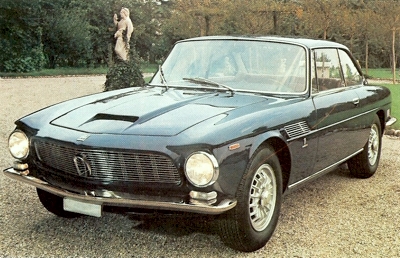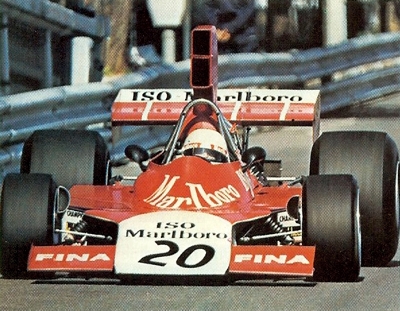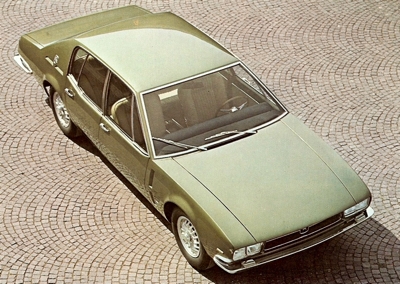THE ISO COMPANY was never in the same league as Ferrari, Maserati and Lamborghini, the surviving great names in the performance cars. Ferrari and Maserati road cars have been offshoots of motor racing; Lamborghini was born of the desire to be better than Ferrari, at a time when Ferrari road cars played second fiddle to the competition side.
Iso, on the other hand, was the product of people who saw an opportunity, had the money and moved in for a killing with what they believed would be a far more suitable car for the well-heeled performance advocate, rather than the highly-strung machinery already dominating the scene.
In a way, they succeeded, but in 1974 they found difficulties in producing cars which were that much cheaper than their V12-engined counterparts, simply because Isos were still Italian supercars. This meant that they had supercar interiors and supercar finish. Steadfastly, Iso remained confident that the small saving was worth it.
Iso was the creation of a family business run by Renzo Rivolta. The initial wealth came from the production of mopeds and other two-wheelers after World War 2, at a time when Italy was in urgent need of transport but could not afford four wheels. Rivolta saw that the demand for two wheels was only a transient thing and that future progress would depend on super-economy four-wheelers.
As a logical extension of their existing business, the Rivoltas designed and developed the Isetta bubblecar which turned out to be perfect timing considering the Suez crisis that occured at the same time. Of course thie same oil-producing nations would conspire against Iso a little further down the road - but the Isetta did pave the way for the future production. BMW saw the Isetta as being exactly what was needed to counter the fuel crisis in increasingly affluent Germany.
Using American V8 Power
The resultant deal did the Rivolta fortunes a lot of good and moved them into the field of the big-time GTs. The idea was that the first GT had to be practical and uncomplicated, something that would appeal to the buyer who thought that with every Ferrari or Maserati a prerequisite for ownership was to have a full-time mechanic travelling in the luggage compartment.
They knew they needed a proprietary engine since the cost of setting up an engine plant, to say nothing of the difficulty in designing and developing a unit from scratch, was prohibitive. There was no shortage of Chevrolet engines, so a supply of V8s was arranged, some with automatic transmission already attached and others ready to be fitted with ZF manual boxes.
Bertone Design the Body's
That part was easy enough; so was the consultation with the Bertone organisation, on the outskirts of Turin. They agreed to supply the Rivolta establishment with some ideas for bodies that would not be too revolutionary and that would carry four adults comfortably enough, plus a reasonable quantity of luggage.
At almost exactly the same time, the British Gordon-Keeble company was commissioning Bertone to style a body for its very similar project. The important difference was that the Gordon-Keeble team already had a chassis and they took it to Bertone so that the prototype could be built. When a chassis was eventually delivered to Bertone for the Iso prototype, it was very similar indeed to the Gordon-Keeble's. It had a tubular frame, discs all round and de Dion rear end. In fact, they were very close to being interchangeable.
Whatever the reason for this surprising coincidence, they were good chassis that worked efficiently in their role as four-seater GTs. The very first Iso Rivolta, as the new Italian car was named, appeared before the public in the autumn of 1962. It was greeted with enthusiasm. After all, it was a practical, good-looking car, capable of 150 mph, and ideally suited to markets outside Europe, where the Iso Rivolta was successful from the outset. It may have lacked the development and engineering finesse of some of the more sophisticated, long-standing makes, but it was a prestige car - at a prestige price - and it found buyers waiting both here in America and even as far away as Hong Kong and Australasia.
 Arguably the most famous Iso is the Rivolta, styled by Bertone. This publicity shot was taken in 1963, although the car was released the previous year. It was fitted with a 5.3 liter Chev V8.
Arguably the most famous Iso is the Rivolta, styled by Bertone. This publicity shot was taken in 1963, although the car was released the previous year. It was fitted with a 5.3 liter Chev V8.
 Go through the history archives and you will come across the Iso entered in F1 by Frank Williams. It was not an Iso, but they sponsored the car, and so inherited the name. Unlike Ferrari, who entered their own product.
Go through the history archives and you will come across the Iso entered in F1 by Frank Williams. It was not an Iso, but they sponsored the car, and so inherited the name. Unlike Ferrari, who entered their own product.
 Iso S4, introduced in 1967, however its name was changed the following year to the Fidia. Fitted with a Chev V8, it was good for either 300 or 365bhp. The body was styled by Ghia - and the most famous of its customers was the outstandingly brilliant John Lennon.
Iso S4, introduced in 1967, however its name was changed the following year to the Fidia. Fitted with a Chev V8, it was good for either 300 or 365bhp. The body was styled by Ghia - and the most famous of its customers was the outstandingly brilliant John Lennon. |
The original trauma of getting the car off the ground had given the Rivoltas a nasty fright. They were well aware that they needed additional expertise if the Iso Rivolta were not to be the first and last of the line. Certainly they needed help if they were to catch the US market, particularly while it was in the grip of Corvette Stingray fever. At the time US buyers had fallen in love with the sports-car image typified by the Corvette Sting-Ray.
Giotto Bizzarini and the Griffo
Salvation appeared in the form of a young engineer named Giotto Bizzarini who had previously been working on some of Ferrari's GT projects and who was later to build cars under his own name before having a brief and disastrous flirtation with American Motors. As he had done before and was to do later, Bizzarini quickly grasped the problem at Rivolta's establishment (on the grounds of the family estate outside Milan) and set to work designing the muscle-car of the line, the Iso Grifo.
Again Bertone styled, the Grifo was a great success in the places where the Iso Rivolta had been such a good car to own. The measure of the car's success was in its longevity: the last few were rolling off the line at the beginning of the summer, 1974, after close on a decade of continuous production.
Engine capacities fluctuated upwards to as much as seven liters, but were always either Chevrolet or Ford V8s. Good aerodynamics and 'the sheer beefy performance ensured that the Grifo was one of the fastest of road cars, its top speed being a claimed 186 mph. Even allowing a fair percentage for the optimism inherent in Italian specialist-car builders, the Grifo was a fast car and just the thing for upstaging a Stingray-owning next-door neighbour.
Having outgrown the little factory on the family estate, the Rivolta entourage moved camp to a site in an Milan. Once they had moved, their first task was to get some new models rolling. Although the concept of the original Iso Rivolta was not dated, its looks certainly were, particularly when placed against rivals which had grown from strength to strength. The Gordon-Keeble was extinct by then, but Jensens were doing well outside Europe and Maserati, Ferrari and Lamborghini had by then put a lot of effort into the GT field.
With the demise of Maserati's big Quattroporte saloon, there was an obvious gap in the market for a large, prestigious four-to-five-seater saloon, both for the Italian market itself and for non-European countries. Despite Fiat's valiant attempts with their 130 saloon (and later the coupe), rich Italians were preferring Mercedes-Benz rather than home-grown products. Even the Pope was using a Mercedes.
The Iso Lele and Fidia
The Lele was launched to replace the Iso Rivolta. A similar package to its forebear, the Lele was again styled by Bertone and, despite its coupe-like stance, revealed itself to be a full four-seater, having a top speed nudging 150 mph, and optional automatic transmission and ZF power steering.
Again, it was aimed at traditional Iso buyers: all the exotic-car cosmetics without the alleged hang-ups of sophisticated engineering. The big saloon, the Fidia, followed a similar design philosophy. Unlike the Lele, which has had predictable success in predictable places, the Fidia did not enjoy the same fortunes, mainly because it was the wrong car at the wrong time.
The perpetual uncertainty in Italy militated against sales there and the mid 1970's oil crisis did not help big car sales. Nevertheless, Fidias did manage to make a little headway in the US, where their size and thirst was in fact smaller than a typical sedan. Unfortunately however, other more subtle forces had been working against Iso. High labour costs, pushed to even greater heights by strikes and increased material costs, drove prices of the Isos ever-closer to those of the more sophisticated vehicles.
Advanced management techniques by the new owners of Maserati (Citroen), Ferrari (Fiat) and Lamborghini (the Swiss family Rosetti) helped keep their prices down to competitive levels, but Iso and, to some extent,
de Tomaso, with similar design philosophies, were loners, miraculously surviving against soul-destroying odds that would have killed lesser companies. The strain of trying to manufacture cars or anything else constructive in Italy, no doubt contributed to the death of Renzo Rivolta in the late 1960s.
The Iso Varedo
His son took over and again called upon the services of Bizzarini, who, following the debacle with American Motors, had retired to his small vineyard at Livorno to grow wine instead of making cars. The outcome of this fresh liaison was a mid-engined two-seater called the Varedo. It was envisaged as a Grifo replacement. When it was shown at the Tusin Motor Show, in 1972, it was far from complete and, in fact, was never finished, because it just did not seem a practical proposition.
In order to get a new-model programme under way, Rivolta had also retained the services of Ing. Dallara, a young, bespectacled engineer from Parma, who designed the Lamborghini Miura before going into semi-retirement to pursue his own interests. However, he emerged from time to time to handle the Pantera and Deauville projects for de Tomaso, as well as to turn the futuristic Lancia Stratos from a very good idea into a rally winner.
Dr lro Pera
Unfortunately, the difficulties of keeping the business going drove Rivolta to such despair that he sold out to US refrigeration tycoon, Dr lro Pera, who put his youthful Sicilian son-in-law, Carlo Beltiore, in charge. In 1974, he was bearing the burden ofthe labour problems and trying to rationalise production techniques in the hope of getting a generally bad situation onto a safer part of the tightrope. Meanwhile, the Varedo project had been killed off, along with the new-model programme. The new management however, hadn't bargained for the labour situation deteriorating still further and in 1975 Iso ceased production.
Also see: Iso Car Reviews
